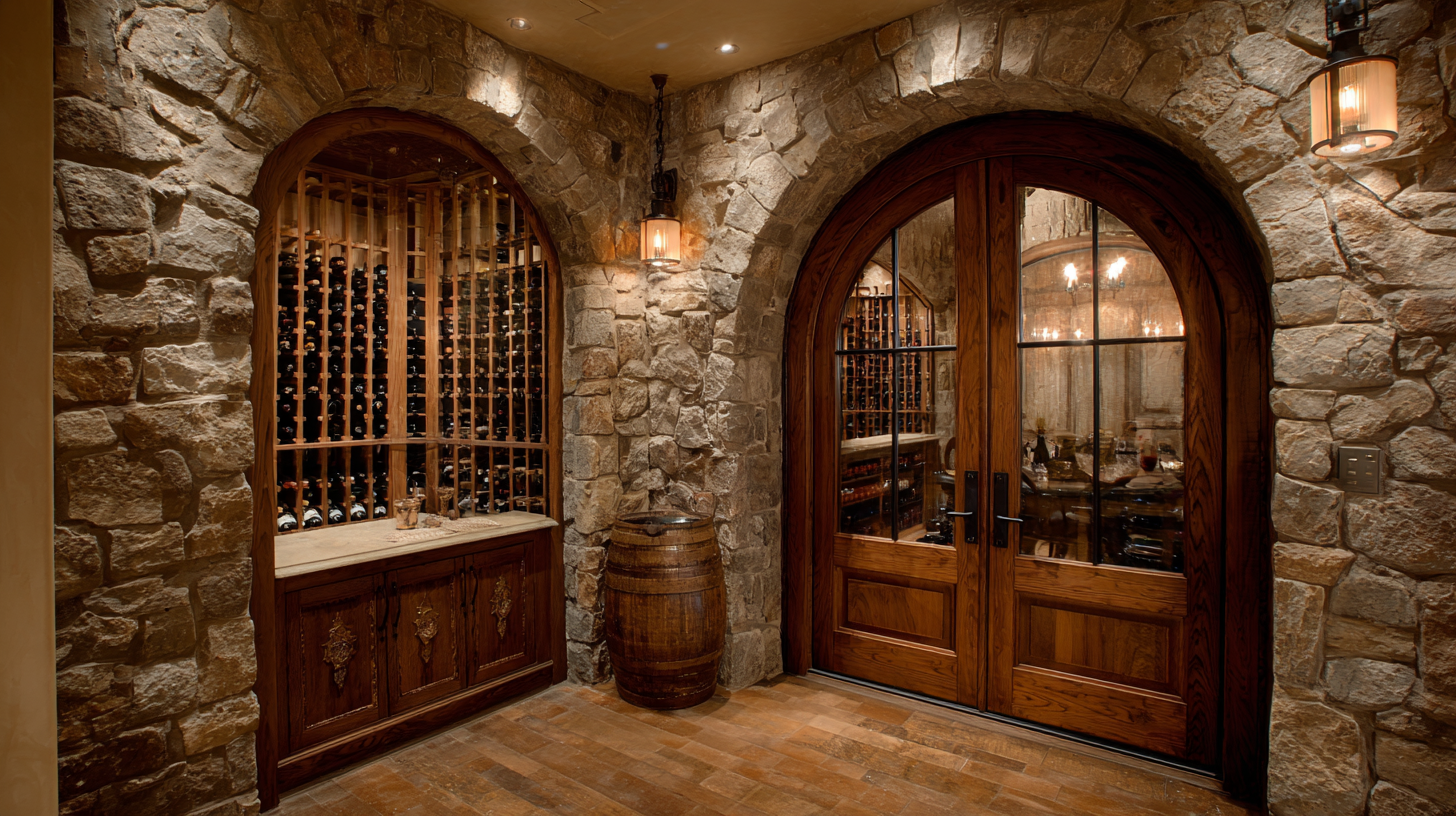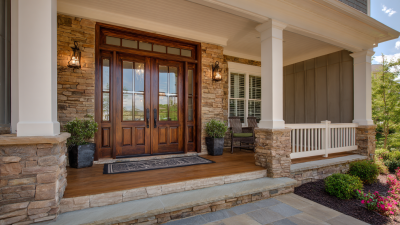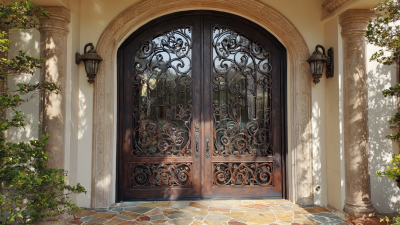We ship across the U.S. and Canada. Visit our showrooms in Atlanta, Tampa and Naples and Nashville!
Ultimate Guide to Choosing the Perfect Wine Cellar Doors for Your Home
When it comes to creating the ideal home wine cellar, choosing the right wine cellar doors is a crucial decision that can significantly impact both the aesthetic and functional qualities of your space. Recent industry reports indicate that properly designed wine cellar doors not only help maintain optimum temperature and humidity levels, essential for wine preservation, but also enhance the overall ambiance of a wine cellar.

According to the Wine Industries Global Market Report, doors specifically engineered for wine storage can reduce thermal conductivity by up to 60%, ensuring that your collection remains in perfect condition. Furthermore, with the rising popularity of home wine cellars in the United States, which has seen a remarkable growth rate of 25% over the past five years, homeowners are increasingly recognizing the importance of choosing doors that reflect their style while providing superior protection. This guide will help you navigate the various options available to select wine cellar doors that truly complement your home and safeguard your valuable collection.
Understanding the Importance of Selecting the Right Wine Cellar Door Style
Choosing the right wine cellar door style is crucial not only for aesthetic appeal but also for maintaining the ideal environment for your wine collection. A well-chosen door can significantly impact temperature and humidity levels, which are vital for preserving wine quality. According to the Wine Institute, wine should be stored at a constant temperature of around
55°F with humidity levels between 50-70%. The right door, such as insulated or dual-pane glass options, can help achieve these conditions by preventing heat exchange and minimizing UV exposure, which can degrade wine.
Additionally, the style of your wine cellar door can enhance the overall design of your space. Industry experts suggest that wooden doors can provide an elegant touch while ensuring effectiveness in insulation and soundproofing. A report by the National Association of Home Builders indicates that features like proper sealing and quality materials can improve the energy efficiency of wine cellars, leading to lower energy costs over time. Selecting a door that harmonizes with your home’s aesthetic while providing functionality reflects both style and practicality, making it a critical aspect of wine cellar design.
Key Materials for Wine Cellar Doors: Pros and Cons Explained
When selecting the perfect wine cellar doors for your home, the choice of materials plays a crucial role in both functionality and aesthetics. Wood, glass, and metal are the primary materials used for wine cellar doors, each with its unique advantages and disadvantages. Wood doors, often favored for their classic appeal, provide excellent insulation and can help maintain a stable temperature and humidity level, vital for wine preservation. However, they can be susceptible to warping over time if not treated properly.
On the other hand, glass doors offer a modern look and allow for easy viewing of your collection. They often come with a dual-pane design that provides insulation, although they require a more controlled environment to prevent temperature fluctuations. A report from the Wine Institute suggests that a consistent temperature of 55°F (13°C) is essential for optimal wine aging, making the choice of door material particularly significant. Lastly, metal doors are highly durable and secure, making them an excellent choice for those with robust safety concerns, but they may require additional insulation measures to ensure the right environmental conditions inside the cellar. Selecting the right material is thus essential for balancing style, safety, and the ideal storage environment for your wine collection.
How to Assess Insulation and Temperature Control in Wine Cellar Doors
When selecting wine cellar doors, assessing insulation and temperature control is paramount to preserving the quality of your wine. High-quality doors are designed to create a barrier that minimizes temperature fluctuations, keeping the cellar environment stable. Look for doors made from materials with excellent insulating properties, such as solid wood or insulated glass. These materials help maintain a consistent temperature, shielding your wine from external heat sources that can cause spoilage.
Additionally, consider the door's sealing mechanisms. A well-sealed door prevents air leaks, which can lead to unwanted temperature changes and humidity levels. Check for features like weather stripping or magnetic seals that enhance airtightness. Understanding the specific insulation ratings, such as R-value, can also guide your decision-making process. A higher R-value indicates better insulation performance, making it easier for your wine cellar to maintain the desired conditions for aging and storing wine. By carefully evaluating insulation and temperature control features, you can ensure your wine cellar doors will provide the necessary protection for your wine collection.
Ultimate Guide to Choosing the Perfect Wine Cellar Doors for Your Home
| Feature | Description | Benefits |
|---|---|---|
| Insulation | High-quality insulation materials like polystyrene or foam core. | Helps maintain a stable temperature, essential for wine preservation. |
| Seal Quality | Tight-fitting door seals that prevent air leaks. | Ensures consistent humidity and temperature levels. |
| Glass Type | Double or triple glazed glass with UV protection. | Protects wine from harmful UV rays while providing visibility. |
| Material | Solid wood, metal, or fiberglass options. | Durability and aesthetics to match the home decor. |
| Door Size | Variety of standard and custom sizes available. | Allows for optimal space utilization and air flow. |
| Design | Options for decorative glass and paneling. | Enhances visual appeal while serving vinyl functional needs. |
Choosing the Right Size and Fit for Your Wine Cellar Entrance
When selecting the ideal wine cellar doors, understanding the right size and fit is essential for both functionality and aesthetics. First, take precise measurements of your wine cellar entrance to ensure a seamless connection between the space and the rest of your home. The door should complement the overall design while also providing enough clearance for moving bottles and equipment in and out. Consider whether you want a single or double door configuration; double doors can offer a more grand entrance while also making it easier to accommodate larger wine racks.

Beyond the dimensions, the fit of the door is crucial in maintaining the right temperature and humidity levels within your wine cellar. A well-fitted door minimizes air leakage, which protects the wine from environmental factors that could alter its flavor profile. Look for doors with weather stripping or seals that enhance insulation. Additionally, selecting a door with high thermal mass can further support your wine preservation efforts. By prioritizing the correct size and fit, you'll create a functional and elegant entrance that ensures your wine collection is in prime condition.
Design Considerations: Aesthetic Choices for Your Wine Cellar Doors
When selecting the perfect wine cellar doors, aesthetic choices play a pivotal role in enhancing the overall ambiance of the space. According to a report by the American Society of Interior Designers, nearly 70% of homeowners prioritize visual appeal when investing in home features like wine cellars. This underscores the importance of choosing doors that not only protect your wine collection but also complement the architectural style of your home.
Materials such as solid wood, glass, and metal each offer distinct visual characteristics that can dramatically influence the perception of a wine cellar. For instance, custom wood doors can infuse warmth and elegance into the room, while glass doors create an open and modern feel, allowing light to filter through without compromising temperature control. Data from the National Association of Home Builders indicates that well-designed wine cellars can increase home value by up to 15%, making the choice of door style even more significant. Whether you prefer a rustic charm or sleek contemporary lines, the right aesthetic choices for your wine cellar doors will ultimately enhance your wine storage experience.

Related Posts
-

Why Choosing a Double Door Front Door Can Elevate Your Home's Curb Appeal
-

Wrought Iron Security Doors Market Insights and Trends at 2025 China 138th Import and Export Fair
-

Exploring Wrought Iron Single Entry Doors Market Trends at the 138th Canton Fair 2025
-

Exploring Elegant Entry Doors Innovations at the 2025 China Import and Export Fair
FROM THE BLOG
-
19
Feb
5 Ways to Improve Front Door Security
0 comments
-
17
Jan
Budgeting For Your Wine Cellar
0 comments
CONTACT INFO
(866) 440-8136
Hours of Operation
Mon - Fri: 9:00am to 6:30pm
Sat: 10:00am to 4:00pm
